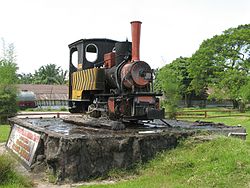Sawit Seberang
| Sawit Seberang field railway | |
|---|---|
|
Memorial near Sawit Seberang, July 2008
| |
| Gauge : | 700 and 1067 mm |
Sawit Seberang - also written as Sawit Sebrang - the name of a sub-district (kecamatan) in the district of Langkat , the northern administrative district of the Indonesian province of North Sumatra , in the northern part of the island of Sumatra lies.
This article describes the palm oil factory Pabrik Kelapa Sawit (PKS) Sawit Seberang and its field railway . It is located in this sub-district and takes its name from the nearby small town of the same name.
Infrastructure
The factory is located near the northeastern border of Sawit Seberang, north of Medan , about 30 km northwest of the city of Stabat - now the seat of the government of Langkat - and north of the city of Binjai , earlier written as Bindjai . It is one of more than two dozen locations of PT Perkebunan Nusantara II (PTPN II). PTPN II was founded in March 1996 and consists of agricultural enterprises that grow palm oil, sugar, rubber and tobacco on an area of 117,169.47 hectares in North Sumatra. The head office is in Tanjung Morawa, about 10 km south of Medan, on the main road to Tebing Tinggi .
During the colonial period, the Sawit Seberang plantations extended to the fields near the town of Gohor Lama, about 13 km to the south-east. It is not yet known when the factory was built and when the factory railway went into operation. The track width of the plantation railway was 700 mm.
The transport of palm fruits from the plantations to the factory by light rail was given up in the early 2010s. Most of the tracks have now been removed. One of the last active locomotives was parked in 2012 next to the tracks that were last in service.
Locomotives
The delivery of steam locomotives of German origin began in the mid-1920s with a C-coupled tank locomotive from Orenstein & Koppel with the factory number 11119. It was delivered to the Sawit Sebrang plantation by C. Schlieper and put into service as number 11 . A second machine from the same manufacturer with the serial number 12247 was delivered in 1933 via NV Spoorijzer from Delft (Netherlands) and is said to have received the number 7 , but it would have to have been renumbered to 6 at some point , because it was the only steam locomotive under this name until today preserved as a memorial at the factory. In the late 1930s, Jung delivered a D-coupled tank locomotive with the serial number 8467 to the factory via P. Jemun, Amsterdam, as number 5 . Other deliveries from the Dutch company Du Croo & Brauns in Weesp date around the same time.
Dieselification of the works railway began in the early 1950s with deliveries from the English Ruston Hornsby. These locomotives were gradually replaced by machines from the German companies Schöma and Diema . These went to this location from 1963 to 1981. Many locomotive numbers were assigned twice on the occasion of replacement deliveries. In the 1980s there were reports of more than two dozen existing diesel locomotives, the oldest of which were turned off and used as spare parts donors. The most recent and certainly last delivery were two machines in 1985 from the Japanese Hokuriku Juki Kogyo Co Ltd from Niigata. This company also delivered many other light rail locomotives to Indonesian sugar factories in Java around the same time. These two machines were the only remaining operational machines for a long time. During a tour in July 2008, these two Japanese locomotives were still used to collect the palm oil fruits on the plantations and to bring them to the small factory in the afternoon. All other existing diesel locomotives had been parked in the locomotive shed for a long time at that time. At that time, the greater part of the palm fruits came by truck from the plantation to the factory, as everywhere else, where the fruits were loaded onto light rail vehicles and maneuvered with forklifts and rope winches. The reason for this transhipment, which was still practiced for a long time, is, as with the sugar factories in Java, the nature of the existing loading facilities.
- Sightings in July 2008
| Surname | design type | Manufacturer and type (serial number / year of construction) | comment | photo |
|---|---|---|---|---|
| 6 (formerly 7) | Bn2t | Orenstein & Koppel 50 PS (12247/1933) | monument |
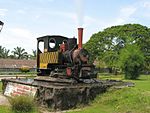
|
| D 04 | B-ie | Schöma CFL45D (2927/1966) | switched off |
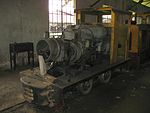
|
| D 05 (formerly D 13 II) | C-ie | Diema DFL90 / 1.D (4428/1980) | switched off |
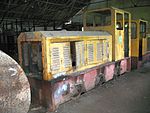
|
| D 15 II | B-ie | Hokuriku Juki Kogyo HDB-6LS (6142-1 / 1985) | in action |

|
| D 16 II | B-ie | Hokuriku Juki Kogyo HDB-6LS (6142-2 / 1985) | in action |

|
| D 24 | C-ie | Schöma CFL150C (4206/1977) | switched off |
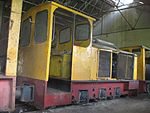
|
If the notation in the delivery list is correct, the D 05 supplied by Diema is the only built machine of the type DFL90 / 1 D. The D probably stands for a three-axis machine, but this has not been confirmed as most of Diema machines were of comparable types two-axle locomotives. There was also a connection to the PT Kereta Api Indonesia (Persero) state railway on the route from Binjai to Tanjung Pura. Schöma again delivered a single machine for this Cape- gauge connecting railway in 1978 with the serial number 4240 in 1067 mm gauge.
Individual evidence
- ↑ Profile Perusahaan PTPN II ( Memento of the original from February 4, 2017 in the Internet Archive ) Info: The archive link was automatically inserted and not yet checked. Please check the original and archive link according to the instructions and then remove this notice.
- ↑ Divre1Rail fans
- ↑ Delivery lists, CD, by Jens Merte, Netphen, Germany
Web links
Coordinates: 3 ° 47 ′ 53.5 ″ N , 98 ° 16 ′ 32.5 ″ E
